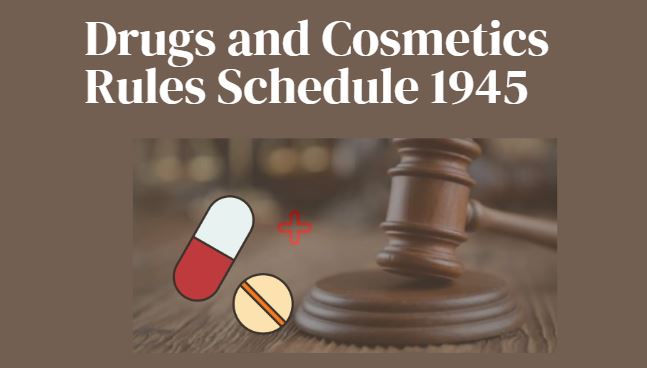The Drugs and Cosmetics Rules 1945 is the set of rules under the Rules of Drugs and Cosmetic Act 1940, which keep the provisions for the classification of medicine. Below are the given schedules and Also described guidelines for the sales, storage, display, and prescription of drugs in each schedule.

List of Drug and Cosmetic Schedules:
Schedule A: Application for license for import, manufacture, and sale of the drug and cosmetic, the forms in which the license is granted and renewed, and other forms.
Schedule B: Fees for drug analysis and Cosmetics that must be paid to the central drug Laboratories or other government laboratories.
Schedule C: List of biological and immunological products, antibiotics and ophthalmic lotions and ointments, and other products for parenteral use (injection).
Schedule C(I): List of drugs from a biological origin, Namely alkaloids, Hormones, vitamins, and antibiotics for oral use.
Schedule D: Exemptions that are granted to drugs and importers of medicine from complying with the necessities of import of medicine and additionally the conditions for exemptions.
Schedule E: A list of poisons with which labeling and other requirements were to comply with.
Schedule E(I): List of poisonous substances under the Ayurvedic Sidha and Unani system of medicines. Examples: Sarpa Visha (Snake venom), Parada (Mercury), etc.
Schedule F: Special provisions to be complied with for manufacturing, testing, and labeling of biological products for human use like Sera and Vaccines. These provisions have now been deleted under drugs and cosmetics rules. The requirements for the running blood bank and other requirements are now included in this schedule.
Related Topic: List of Drugs Schedule C, C1, G, H, H1, K, P, M, N, and X with CAUTION and WARNING
Schedule F(I): Special provisions to be complied with for manufacturing, testing, and labeling veterinary biological products.
Schedule F (II): Standards for surgical dressing.
Schedule F(III): Standards for umbilical tapes.
Schedule FF: Additional standards for ophthalmic preparations.
Schedule G: List of drugs that should be used by the patient under medical supervision and which shall be labeled with the words “Caution- it is dangerous to take this preparation without medical supervision.
Schedule H: List of drugs that are to be sold by retail against the prescription of a registered medical practitioner and which shall be labeled with “Rx” words “schedule H drugs
Warning: to be sold by retail on the prescription of an RMP only”. An example are androgenic, anabolic, estrogenic, and progestational substances; Alprazolam (Xanax), Hepatitis B vaccine, Ibuprofen, Vasopressin, etc.
Schedule I: List of poisons and particular about the proportion of poison in certain cases. Schedule I was linked with Schedule E. When Schedule E was deleted in 1982 under Drugs and Cosmetics rules, schedule I is not currently accepted. Examples of these types of drugs as heroin, lysergic acid diethylamide (LSD), marijuana (cannabis), 3,4-methylenedioxymethamphetamine (ecstasy), methaqualone, and peyote.
Schedule J: Names of diseases and ailments (by whatever name described) which are drugs may not purport to prevent or cure by means of claims made on the label of the container of the drug.
Schedule K: Names of drugs for classes of drugs that are exempted from complying with the previous for manufacture, sale, and Standards of drugs and the conditions of such exemptions.
Schedule L: List of drugs that were required to be sold by retail against the prescription of a registered medical practitioner. Subsequently, the drugs listed in Schedule L were transferred to Schedule H. After that Schedule L was deleted in 1982.
Schedule M: Good manufacturing practice (GMP) and the requirements of premises, plant, and equipment for the manufacture of drugs.
Schedule M(I): Requirements for factory premises of homeopathic medicine.
Schedule M(II): The requirement of factory premises of cosmetics.
Schedule M(III): The requirement of factory premises for the manufacture of medical devices.
Schedule N: List of minimum equipment requirements of furnaces for the effective running of the pharmacy.
Schedule O: Standards for disinfectant fluids.
Schedule P: Life period and conditions of storage of drugs.
Schedule P(I): Pack sizes of drugs.
Schedule Q: List of Coal Tar classes permitted to be used in cosmetics.
Schedule R: Standards and labeling requirements of condoms, copper-T, and contraceptive tubal rings.
Schedule R(I): Standards to be complied with by medical devices.
Schedule S: Standards for cosmetics.
Schedule T: Requirements of factory premises and hygiene conditions to be complied with by the manufacture of Ayurvedic, Siddha, and Unani drugs.
Schedule U: Particulars to be shown in the manufacturing record, a record of the raw materials, and the analytical records of the drugs.
Schedule V: Standards for the patient and proprietary medicines and additionally the minimum quantities of Vitamins that are permissible to be added in such preparations for oral use.
Schedule W: Name of drugs that shall be marketed under generic names only.
Schedule X: Names of psychoactive drugs that special control measures are laid down. The distributor should keep a duplicate of the prescription for two years.
Examples of such types of drugs are Secobarbital, Glutethimide, etc.
Schedule Y: Requirements and guidelines on clinical trials for the import and manufacture of new drugs.
Read Also: Polymerase Chain Reaction (PCR)
REFERENCES:
CDSO— Drug and Cosmetic rules act 1940 and rule 1945 Pdf

Naresh Bhakar is the Founder and Author at Pharmaguddu.com, bringing his extensive expertise in the field of pharmaceuticals to readers worldwide. He has experience in Pharma manufacturing and has worked with top Pharmaceuticals. He has rich knowledge and provides valuable insights and data through his articles and content on Pharmaguddu.com. For further inquiries or collaborations, please don’t hesitate to reach out via email at [email protected].
